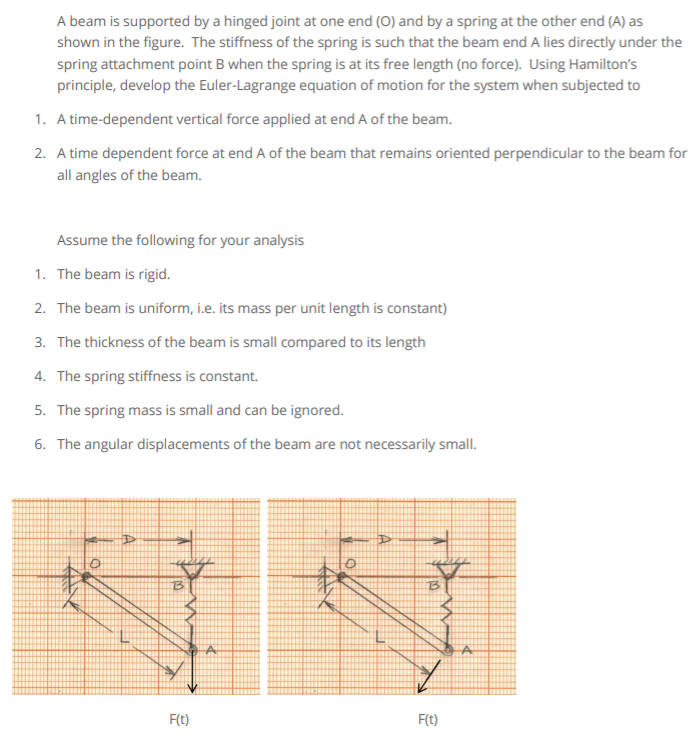A beam is supported by a hinged joint at one end (0) and by a spring at the other end (A) as shown in the figure. The stiffness of the spring is such that the beam end A lies directly under the spring attachment point B when the spring is at its free length (no force). Using Hamilton's principle, develop the Euler-Lagrange equation of motion for the system when subjected to 1. A time-dependent vertical force applied at end A of the beam. 2. A time dependent force at end A of the beam that remains oriented perpendicular to the beam for all angles of the beam. Assume the following for your analysis 1. The beam is rigid. 2. The beam is uniform, i.e. its mass per unit length is constant) 3. The thickness of the beam is small compared to its length 4. The spring stiffness is constant. 5. The spring mass is small and can be ignored. 6. The angular displacements of the beam are not necessarily small.
A beam is supported by a hinged joint at one end (0) and by a spring at the other end (A) as shown in the figure. The stiffness of the spring is such that the beam end A lies directly under the spring attachment point B when the spring is at its free length (no force). Using Hamilton's principle, develop the Euler-Lagrange equation of motion for the system when subjected to 1. A time-dependent vertical force applied at end A of the beam. 2. A time dependent force at end A of the beam that remains oriented perpendicular to the beam for all angles of the beam. Assume the following for your analysis 1. The beam is rigid. 2. The beam is uniform, i.e. its mass per unit length is constant) 3. The thickness of the beam is small compared to its length 4. The spring stiffness is constant. 5. The spring mass is small and can be ignored. 6. The angular displacements of the beam are not necessarily small.
Classical Dynamics of Particles and Systems
5th Edition
ISBN:9780534408961
Author:Stephen T. Thornton, Jerry B. Marion
Publisher:Stephen T. Thornton, Jerry B. Marion
Chapter7: Hamilton's Principle-lagrangian And Hamiltonian Dynamics
Section: Chapter Questions
Problem 7.32P
Related questions
Question
urgent please

Transcribed Image Text:A beam is supported by a hinged joint at one end (0) and by a spring at the other end (A) as
shown in the figure. The stiffness of the spring is such that the beam end A lies directly under the
spring attachment point B when the spring is at its free length (no force). Using Hamilton's
principle, develop the Euler-Lagrange equation of motion for the system when subjected to
1. A time-dependent vertical force applied at end A of the beam.
2. A time dependent force at end A of the beam that remains oriented perpendicular to the beam for
all angles of the beam.
Assume the following for your analysis
1. The beam is rigid.
2. The beam is uniform, i.e. its mass per unit length is constant)
3. The thickness of the beam is small compared to its length
4. The spring stiffness is constant.
5. The spring mass is small and can be ignored.
6. The angular displacements of the beam are not necessarily small.
F(t)
F(t)
Expert Solution
This question has been solved!
Explore an expertly crafted, step-by-step solution for a thorough understanding of key concepts.
This is a popular solution!
Trending now
This is a popular solution!
Step by step
Solved in 2 steps with 2 images

Knowledge Booster
Learn more about
Need a deep-dive on the concept behind this application? Look no further. Learn more about this topic, physics and related others by exploring similar questions and additional content below.Recommended textbooks for you

Classical Dynamics of Particles and Systems
Physics
ISBN:
9780534408961
Author:
Stephen T. Thornton, Jerry B. Marion
Publisher:
Cengage Learning

Classical Dynamics of Particles and Systems
Physics
ISBN:
9780534408961
Author:
Stephen T. Thornton, Jerry B. Marion
Publisher:
Cengage Learning